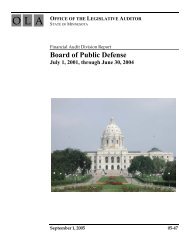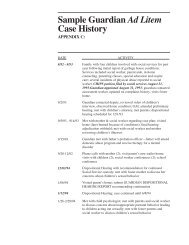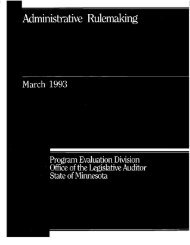Occupational Regulation - Office of the Legislative Auditor
Occupational Regulation - Office of the Legislative Auditor
Occupational Regulation - Office of the Legislative Auditor
You also want an ePaper? Increase the reach of your titles
YUMPU automatically turns print PDFs into web optimized ePapers that Google loves.
EFFECTIVENESS OF OCCUPATIONAL REGULATION 75<br />
While we raise <strong>the</strong>se issues, we do not have definitive answers, but we think <strong>the</strong>re<br />
is some evidence to question whe<strong>the</strong>r our policy on financing is working well in<br />
all cases.<br />
Our survey <strong>of</strong> 48 agency and board managers responsible for occupational<br />
regulation found seven managers’ top complaint was about inadequate staffing or<br />
inadequate financial resources. There were o<strong>the</strong>r complaints about <strong>the</strong> high cost<br />
<strong>of</strong> investigations and five managers complained about unlicensed practitioners.<br />
Several people we talked with thought that regulatory fees alone should not be<br />
expected to finance enforcement <strong>of</strong> laws against unlicensed practitioners, since<br />
licensed practitioners were in a sense penalized for <strong>the</strong> behavior <strong>of</strong> unlicensed<br />
practitioners.<br />
It is difficult to<br />
learn <strong>the</strong> cost <strong>of</strong><br />
occupational<br />
regulation in<br />
state agencies.<br />
We found two indications that financing regulation through user fees causes<br />
problems. First, licensing fees vary greatly in large measure because regulatory<br />
financing must be substantially borne by those regulated. Table 3.7 presents a list<br />
<strong>of</strong> <strong>the</strong> 40 highest licensing fees and <strong>the</strong> number regulated in each case. Small<br />
occupations like hearing instrument dispenser, private detective, and podiatrist are<br />
at <strong>the</strong> top <strong>of</strong> <strong>the</strong> list, and most <strong>of</strong> <strong>the</strong> 40 listed occupations represent occupational<br />
groups <strong>of</strong> less than 1,000 people. Attorneys and physicians and dentists and o<strong>the</strong>r<br />
health-related pr<strong>of</strong>essions also have relatively high fees. There were over 21,000<br />
licensed attorneys in mid 1998, for example, and <strong>the</strong>y paid an annual fee <strong>of</strong> $207.<br />
Table 3.7 shows, many lower paid pr<strong>of</strong>essions pay as much or more in annual fees<br />
even though <strong>the</strong>y finance regulatory programs that are quite modest.<br />
Second, when regulation is administered by a state department, it is difficult to<br />
know whe<strong>the</strong>r <strong>the</strong> cost <strong>of</strong> regulation is recovered by fees, because departments<br />
vary in how <strong>the</strong>y categorize and report fee income and expenditures. Departments<br />
in which occupational regulation is a relatively small part <strong>of</strong> department<br />
operations do not account for regulatory revenues and expenditures in a way that<br />
permits a reader <strong>of</strong> financial reports to understand <strong>the</strong> cost <strong>of</strong> regulatory programs<br />
and whe<strong>the</strong>r <strong>the</strong> regulatory fees are reasonably close to regulatory expenditures as<br />
required by Minnesota law. We reviewed data on fee income in <strong>the</strong> Departmental<br />
Earnings Report published by <strong>the</strong> Department <strong>of</strong> Finance, but found it to be<br />
inadequate as a source <strong>of</strong> data on <strong>the</strong> cost <strong>of</strong> occupational regulation. Because<br />
many independent boards are essentially dedicated to occupational regulation, it is<br />
easy to calculate <strong>the</strong> cost <strong>of</strong> <strong>the</strong>ir programs from regularly published tables,<br />
however it is difficult to tell <strong>the</strong> degree to which fees finance regulatory programs<br />
in state agencies, since <strong>the</strong> expenditure <strong>of</strong> fee income is not accounted for<br />
separately and since <strong>the</strong>re are administrative services that departments provide<br />
that are not subject to any formal financial transaction.<br />
ADMINISTRATIVE CONSOLIDATION<br />
As noted in Chapter 2, Minnesota has a relatively large number <strong>of</strong> regulated<br />
occupations and a large number <strong>of</strong> boards and agencies with regulatory<br />
responsibility. Previous analysts have been concerned about <strong>the</strong> effect <strong>of</strong> this type<br />
<strong>of</strong> organizational structure on administrative efficiency. For instance, <strong>the</strong><br />
Department <strong>of</strong> Administration report in <strong>the</strong> late 1970s summarized in Chapter 1<br />
recommended that <strong>the</strong> independent boards be abolished and re-established as








